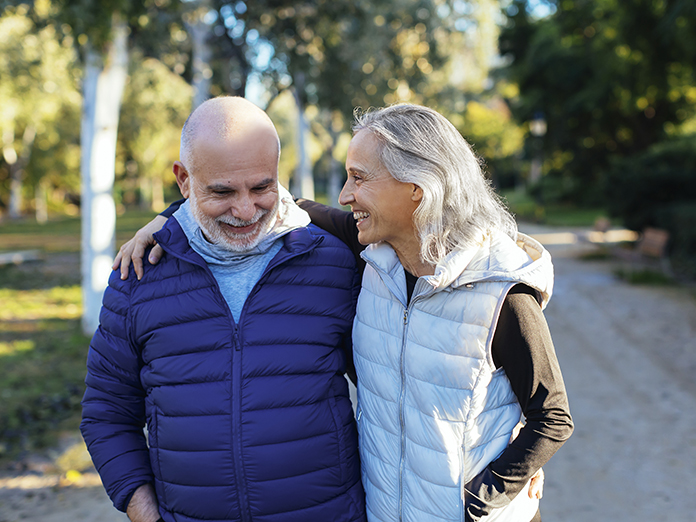The information you will be accessing is provided by another organization or vendor. If you do not intend to leave our site, close this message.
D-SNP home page > Health tips & tools > How to use your smartphone to reduce stress
How to use your smartphone to reduce stress
Ease stress in the moment with these free tools and apps that are already on your smartphone — no downloading needed.
 By Hallie Levine
By Hallie Levine


Smartphones have a bad reputation for causing more stress and anxiety, not less. But your smartphone also has the potential to help you feel calmer in the moment. You just need to know what to look for and how to use it the right way.
“There are a lot of advantages to smartphones, and most of the time you can use apps and functions that are already on it,” explains John Hunter, PhD. He’s an assistant professor in the department of psychology at the Crean College of Health and Behavioral Sciences at Chapman University in Orange, California.
In fact, a study done by Hunter found that your phone can work like a digital security blanket during stressful moments.1 “We found that when people were in awkward social situations, having their phones with them provided comfort and made them feel less alone and less stressed,” he says.
Ready to learn how to use your smartphone to reduce stress? Here are seven expert-approved ways to turn your phone into a pocket-sized stress reliever.
Turn off your notifications.
If you’re constantly getting pinged when you get an email, a Facebook ‘like’ or a breaking news alert, it’s time to dial it down a notch. “When you’re constantly connected, it can lead to anxiety,” says Hunter.
Another reason to create a little separation: The more often you’re on social media, the more likely you are to feel anxious and depressed, according to one national study.2 The study authors offered a few explanations for this. For one, multitasking — in this case, switching back and forth between platforms like Facebook, YouTube and Twitter — has been linked with poor mental health. Plus, the more you engage with social media, the easier it is to make social mistakes. That can lead to embarrassment. Instead, try using social media in moderation, along with some of the other tips below.
Make a shared photo album.
If you can’t see family or friends in person, a shared photo album is a great way to stay connected.
Here’s how to do it on an iPhone:
- Open your Photos app, click Albums, then My Albums.
- Tap the + add button in the top left corner.
- Tap New Shared Album.
- Give the shared album a name, then tap Next.
- Choose people to invite from your contacts, or type in an email address or iMessage phone number.
Here’s how to do it on an Android phone:
- Open your Google Photos app.
- Sign into your Google Account.
- At the bottom, tap Photos.
- Select photos or videos for the album.
- At the top, tap +.
- Tap Shared Album and enter an album title.
- When you’re happy with the album, tap Share.
- Select whom to share your album with.
Each person you add to your shared album will also be able to upload their own photos. Now everyone in the group can see the photos and keep up to date on what loved ones are doing. They can also follow up with supportive notes.
Surf for relaxing nature sounds.
You can go on your web browser and search for videos that mimic nature. “Anything like the sound of wind blowing, a brook babbling or waves crashing. These all work to activate your parasympathetic nervous system, which slows your body’s stress response,” explains Hunter. That’s especially important if it’s hard for you to leave your house or get to an outdoor area like a park or beach. Research shows that just watching these types of nature scenes can make you feel happier.3
Set your timer for a mental break.
If you’ve never tried meditation, it’s easier and more relaxing than you might think. You don’t even need a special app to try some basic meditation. Simply set a timer on your smartphone for three to five minutes and do some simple deep breathing, says Bruce Rabin, MD, PhD. Dr. Rabin is a professor emeritus of preventative medicine at the University of Pittsburgh. Try this exercise, which is known as belly breathing:
- Sit in a comfy position.
- Put one hand on your belly, below your ribs, and your other hand on your chest.
- Inhale deeply through your nose, letting your belly push your hand out.
- Breathe out through pursed lips, as if you were about to whistle. Feel the hand on your belly lowering back down.
- Repeat until the timer goes off.
Leave yourself a positive voicemail message.
It can be a minute-long pep talk that points out your strengths and encourages you, suggests Dr. Rabin. You can also try a positive affirmation. One of Dr. Rabin’s favorites is a quote from Mr. Rogers:
“If you could only sense how important you are to the lives of those you meet, how important you can be to the people you may never even dream of. There is something of yourself that you leave at every meeting with another person.”
Then, listen to the message any time you’re feeling stressed or down, or if you just need a quick pick-me-up.
Put your phone into night mode 24/7.
The brightness of your phone can also impact your sleep quality, says Hunter. You can try putting your phone in dark or night mode to see if that helps you feel more relaxed. It’s especially important to do this several hours before bedtime, since bright light from your phone gives off blue light, explains Hunter. That can suppress melatonin, a hormone that makes you feel sleepy.
Call someone.
A phone is a phone, after all. “You use it to connect with other people. And we know social connections ease stress,” says Dr. Rabin. Try a video chat app like FaceTime, which allows you to see the other person and their expressions. That’s very important for maintaining rapport, Dr. Rabin notes. But even if you can’t do a video call, a regular call has benefits too.4 A recent survey conducted by the company weBoost found that talking on the phone instead of texting increased calmness and peacefulness. It also lowered stress and anxiety.
1Hunter JF, Hooker ED, Rohleder N, et al. The use of smartphones as a digital security blanket: the influence of phone use and availability on psychological and physiological responses to social exclusion. Psychosomatic Medicine. May 2018, 80(4): 345-352.
2Primack BA, Shensa A, Escobar-Viera CG, et al. Use of multiple social media platforms and symptoms of depression and anxiety: a nationally-representative study among U.S. young adults. Computers in Human Behavior. April 2017, 69: 1-9.
3University of California. Stressed out by the news? Nature videos will make you happier. March 16, 2017. Accessed June 12, 2022.
4weBoost. Talking on the phone is a good call: full biometric study report findings. April 28, 2020. Accessed June 12, 2022.



